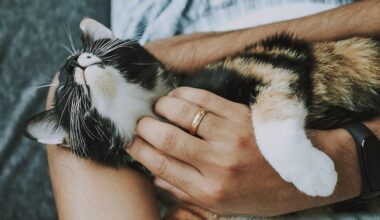How to Educate Family Members About Cat Choking Hazards
When it comes to cat safety, addressing choking hazards is crucial. It’s essential for all family members to understand common choking risks that can pose a threat to our feline companions. One important consideration is the types of toys we bring into our homes. Toys with small parts, such as buttons or marbles can easily be swallowed by cats. To ensure your home is safe, always choose toys specifically designed for cats, free of small detachable pieces. Additionally, keeping an eye on the condition of toys is vital; if they start breaking apart, it’s best to discard them. Food items also present choking hazards, especially human foods that might not be suitable. Familiarizing everyone in the household with proper feeding practices and safe food options goes a long way. Involving children in pet care can also help them learn how to recognize dangerous items, ultimately promoting a safe environment. Encouraging discussions about these topics fosters responsible pet ownership and care, making everyone in the household aware and proactive in keeping your cat safe from choking incidents.
Another important aspect of educating family members about cat choking hazards is understanding the types of items that are commonly hazardous. Items such as rubber bands, string, and even certain types of plants can pose choking threats. Once you identify these items, it’s crucial to develop strategies for their safe management. For instance, always keep rubber bands out of reach and educate your family on the importance of supervising playtime. Everyone should also be aware of the dangers created by non-food objects that cats may be inclined to chew or ingest. Creating a list of unsafe items and posting it in visible places can create awareness in the household. It is equally important to contribute to a clean environment by regularly checking for pet-related hazards. Encourage family members to participate in cleaning up and organizing spaces your cat frequents. This builds a collective responsibility towards ensuring your cat’s safety. By embedding these practices into your pet care routines, you can significantly reduce the risks associated with choking hazards and maintain an enjoyable atmosphere for everyone involved.
Additionally, teaching basic first aid for choking incidents can empower all family members to act confidently if a choking emergency arises. Having discussions that include techniques for recognizing when a cat is choking, such as gagging or distress, can equip everyone with the necessary knowledge. Researching and practicing first-aid techniques can benefit the whole family. You can also hold role-play scenarios that mimic emergencies involving a choking cat. This way, everyone gets to practice their response in a safe and controlled environment, reducing overall panic when a real situation arises. Moreover, having a designated first-aid kit for your pet can ease concerns and ensure immediate access to useful items. This kit should include a manual with step-by-step first-aid instructions specifically for cats. Resources from reliable organizations like the ASPCA can provide thorough guidance. Distributing this information amongst family members will enhance collective preparedness and create a supportive atmosphere for your cat. Constant reviews of these techniques and resources will reinforce understanding and confidence across the board, ultimately prioritizing cat safety.
Identifying Unsafe Locations and Items
Particularly important in preventing choking is regularly assessing your home for unsafe locations and items that may pose risks. For example, areas where children play often contain items that could choke your pet. Encourage family members to actively monitor these spaces, ensuring they are free of small toys and dangerous materials. You may also want to configure feeding locations sensibly to prevent accidents; keeping food bowls on stable surfaces while avoiding places where pets might be distracted enhances safety. Look out for common choking hazards in other areas of the home, including bedrooms or living rooms where unauthorized items or toys may end up. By collaborating as a family unit in these efforts, you can all raise awareness regarding awareness around potential dangers. It might also be helpful to conduct a semi-annual check-up of items to see what should be placed or stored more securely. Recording these findings will emphasize areas of concern going forward, thus improving your shared knowledge. This mission to create a safer home for cats can unite the family and make everyone more vigilant against choking hazards in day-to-day activities.
Reinforcing the training of family members regarding cat choking hazards occurs through positive reinforcement when they adhere to safety protocols. Recognizing and rewarding responsible behavior can foster a sense of duty and encourage others to follow suit. For example, praising children when they remember to close cupboards or store toys correctly can lead to a culture of safety among family members. Attending a workshop on cat safety could also enhance your collective understanding and confidence in managing risks. Many communities offer resources for pet owners to learn more. Engaging in such educational opportunities creates a grateful bond among family members while providing a useful platform for sharing concerns and strategies. Furthermore, making use of social media can amplify traction on the subject; sharing personal experiences or resources may get more people involved in your initiative. Engagement with the feline community can inspire your family as well. Ultimately, infusing a fun element into the learning experience will make it much more effective in driving understanding about serious matters such as choking hazards.
In conclusion, ensuring your cat’s safety against choking hazards begins with a united effort from all family members. Educating everyone about these risks creates a proactive household, fostering responsible cat ownership. By discussing common hazards, safe practices, and first-aid skills, the whole family can participate in maintaining a safe environment for your feline friend. Collaborating in this search for safety can not only raise awareness but also instill a valuable sense of responsibility among all members. Establishing discussions that include kids helps them grow into attentive pet owners themselves and instills important values for dealing with pets. Frequent re-evaluation of the safety status within the home will be vital in identifying and addressing new risks as they arise. Empowering family members with knowledge and confidence to react effectively during emergencies brings peace of mind to your home. As time unfolds, the show of unity and concerted effort towards ensuring a safe environment will be evident, thus allowing your cat to thrive. Together, let’s build an environment that celebrates cat life while keeping them safe from choking hazards.
Final Thoughts on Cat Safety
Education about cat choking hazards is a continuous journey that involves family participation and growth. Making discussions surrounding safety natural and engaging will influence family members’ response levels. Setting a dynamic where everyone feels comfortable discussing potential dangers and strategies for safety reinforces a proactive culture in your home. There is no greater certainty than knowing that your family is aware and capable of acting in times of urgency or when faced with risks. Inclusivity within pet parenting creates a sense of teamwork amongst family members. This unity can lead to a thriving, happy cat while effectively minimizing hazards. Adopting a shared commitment to your feline companion’s safety nurtures emotional connections as well. Ultimately, the goal of ensuring cat safety around choking hazards lies in education that never ends. Stay vigilant and continuity in educating the family makes a world of difference by changing behaviors within the household. Therefore, combining knowledge, resources, and reinforcement creates the foundation of a loving, pet-friendly home that prioritizes cat safety above all.
By following these outlined strategies, it’s possible for families to cultivate an environment where their cats can thrive safely. Everyone’s efforts can significantly influence cat well-being. Prioritizing communication and shared responsibility helps foster a positive atmosphere where everyone works towards shared goals; creating safe spaces for cats is one of those goals that unite us. The more members commit to understanding and mitigating choking hazards, the more likely their cat will lead a joyful, hazard-free life. Remember, any subtle changes or unmonitored items can turn into major problems. Balance excitement and caution is a formula for guaranteeing safety. Encourage creativity in how family members learn about safety, whether through creating games, workshops, or brainstorming ideas frequently. Involving everyone creates a supportive environment that nurtures both learning and love for your pets. Lastly, always be prepared to adapt as new challenges arise since safety is an evolving concept. Cherishing the bond with your cat while ensuring safe practices makes all the difference in nurturing a happy environment.


